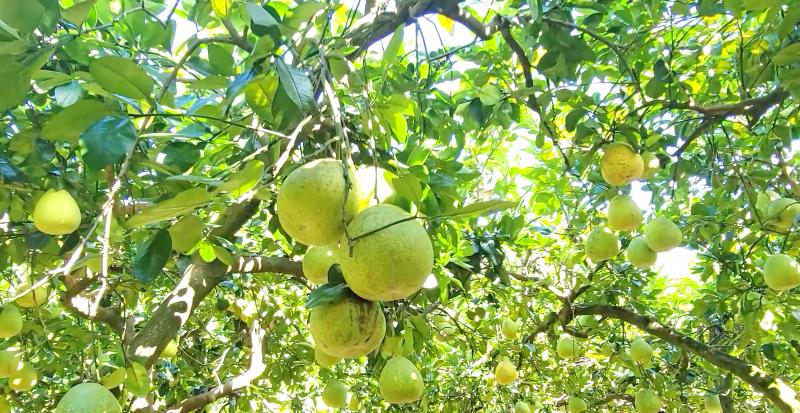Pomelo production is to fluctuate wildly over the next decade, growing steadily until plummeting by 40 percent as climate change affects temperatures and rainfall, Greenpeace Taiwan said on Thursday.
Taiwan produces an average of 74,000 tonnes of pomeloes per year with a steadily rising yield, averaging 13,000kg per hectare over the past five years, the environmental group said.
However, Greenpeace climate change models using data from the Central Weather Bureau and the Ministry of Science and Technology’s Taiwan Climate Change Projection Information and Adaptation Knowledge Platform show dramatic fluctuations in production over the next decade, it said.

Screen grab by Lu Hsien-hsiu, Taipei Times
If carbon emissions continue at their current pace, the two most important pomelo growing regions in the country — Tainan’s Madou District (麻豆) and Rueisui Township (瑞穗) in Hualien County — are to experience the worst production shocks in a century, it said.
Unstable weather could reduce yield from a peak of about 17,900kg per hectare in 2024 to about 12,600kg per hectare by 2029, a decline of 40 percent over a five year period, Greenpeace said.
The primary reason for this dramatic fluctuation is shown to be unstable low temperatures in June, with about 790kg per hectare lost for every 1°C of warming, it said.
June is peak growing season for pomeloes, during which time fluctuations in daily temperatures have a significant effect on fruit development and output, Greenpeace East Asia campaigner Liu Yi-chun (劉羿君) said.
From now until 2024, June temperatures are expected to fall, causing yields to climb, the group said.
However, in the five years that follow, temperatures are expected to rise, resulting in a drop in production from 2024 to 2029, it added.
This variation would directly affect growers’ income, with an oversupply in the next few years potentially tanking prices, followed by a collapse that would pose a challenge to supply and demand, it said.
Aside from rising temperatures, unsteady precipitation would also impact yields, Greenpeace said.
The group said that farmers told them that unstable weather patterns over the past four years have made it difficult to estimate the growing calendar, with typhoons arriving at unusual times and plum rains giving way to drought conditions.
Farmers’ livelihoods depend on the weather, leaving them especially vulnerable to climate change, Liu said.
The Council of Agriculture last month announced a NT$10 billion (US$360.54 million) annual fund to help farmers adapt to climate shocks, but some might never see the money without a plan for how local governments should distribute it, Liu added.
Greenpeace called on local governments to pass ordinances governing the distribution of federal assistance, as well as develop strategies to help farmers deal with climate change through assessing risk and ensuring access to water.

Taiwan is to commence mass production of the Tien Kung (天弓, “Sky Bow”) III, IV and V missiles by the second quarter of this year if the legislature approves the government’s NT$1.25 trillion (US$39.78 billion) special defense budget, an official said yesterday. Commenting on condition of anonymity, a defense official with knowledge of the matter said that the advanced systems are expected to provide crucial capabilities against ballistic and cruise missiles for the proposed “T-Dome,” an advanced, multi-layered air defense network. The Tien Kung III is an air defense missile with a maximum interception altitude of 35km. The Tien Kung IV and V

The disruption of 941 flights in and out of Taiwan due to China’s large-scale military exercises was no accident, but rather the result of a “quasi-blockade” used to simulate creating the air and sea routes needed for an amphibious landing, a military expert said. The disruptions occurred on Tuesday and lasted about 10 hours as China conducted live-fire drills in the Taiwan Strait. The Civil Aviation Administration (CAA) said the exercises affected 857 international flights and 84 domestic flights, affecting more than 100,000 travelers. Su Tzu-yun (蘇紫雲), a research fellow at the government-sponsored Institute for National Defense and Security Research, said the air

A strong continental cold air mass is to bring pollutants to Taiwan from tomorrow, the Ministry of Environment said today, as it issued an “orange” air quality alert for most of the country. All of Taiwan except for Hualien and Taitung counties is to be under an “orange” air quality alert tomorrow, indicating air quality that is unhealthy for sensitive groups. In China, areas from Shandong to Shanghai have been enveloped in haze since Saturday, the ministry said in a news release. Yesterday, hourly concentrations of PM2.5 in these areas ranged from 65 to 160 micrograms per cubic meter (mg/m³), and pollutants were

Taiwan’s armed forces have established response protocols for a wide range of sudden contingencies, including the “Wan Chun Plan” to protect the head of state, the Ministry of Defense (MND) said today. After US President Donald Trump on Saturday launched a series of airstrikes in Venezuela and kidnapped Venezuelan President Nicolas Maduro, concerns have been raised as to whether China would launch a similar “decapitation strike” on Taiwan. The armed forces regularly coordinate with relevant agencies and practice drills to ensure preparedness for a wide range of scenarios, Vice Minister of National Defense Hsu Szu-chien (徐斯儉) told reporters before a